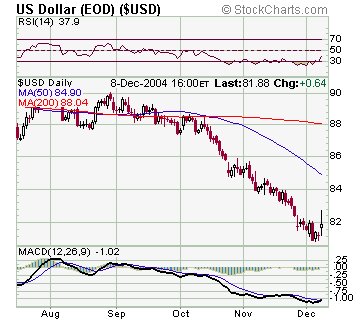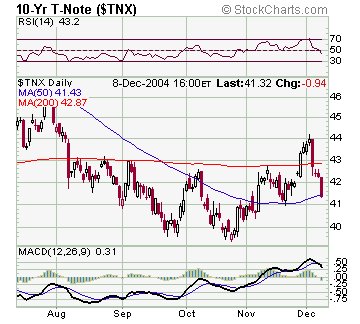Prudent Investor says: THIS IS A MUST READ FOR YOU...
Born Suckers
The greatest Wall Street danger of all: YOU.
By Henry Blodget
Posted Tuesday, Dec. 14, 2004, at 5:11 AM PT
This self-defense guide would not be complete if I did not address the greatest Wall Street danger of all: you.
Human beings, it turns out, are wired to make dumb investing mistakes. What's more, we are wired not to learn from them, but to make them again and again. If there is consolation, it is that it's not our fault. We are born suckers.
In the past 30 years, academic research has progressed beyond efficient-markets theory, which mistook humans for robots, into behavioral finance, which acknowledges that we are, in fact, sweating, breathing, herding, hoarding, pleasure-seeking, pain-avoiding animals who employ a looser definition of "rational" than computer chips. A full enumeration of the innate tendencies that doom most of us to investing mediocrity would fill a hard drive. So, here are some highlights (thanks in advance to James Montier of Dresdner Kleinwort Wasserstein Research, Michael Mauboussin of Legg Mason Funds, Warren Buffett, and www.behaviouralfinance.net):
Self-attribution Bias: We attribute our successes to ourselves, and we blame our losses on others or bad luck. This hobbles us in two ways. First, we don't learn from our mistakes because we don't see them as mistakes. Second, we assume we are skilled or smart when we're just lucky.
The Gambler's Fallacy: We tend to believe, incorrectly, that if a flipped coin has come up heads three times in a row it is more likely come up tails next time. Similarly, just because a stock or market has gone up or down for a while doesn't mean it is more likely to go the other way soon.
Prospect Theory: We have an irrational tendency to sell our winners to lock in profits and keep our losers to avoid taking losses. This causes us to sell too early when the market is going up and too late when it is going down. We also feel the pain of loss more than the pleasure of gain and, therefore, blow out losing positions in panic when we should just hang on.
Conservatism Bias and Confirmatory Bias: Once we form opinions, we tend to overvalue information that reinforces them and undervalue information that undermines them (conservatism bias). We even tend to seek out supporting information (confirmatory bias). Thus, we irrationally cling to incorrect conclusions, and, to paraphrase Simon and Garfunkel, hear what we want to hear and disregard the rest.
Overoptimism: We tend to be overoptimistic and overconfident. According to James Montier, when students are asked whether they will perform in the top half of their class, an average of 80 percent say yes. This tendency makes it easier for part-time hobbyists to dismiss a century's worth of academic research showing that only a tiny fraction of full-time professionals can beat the market.
Outcome Bias: We tend to evaluate decisions based on outcomes instead of probabilities. Thus, we congratulate ourselves for stupid choices that happen to turn out well and vow to never again make smart choices that happen to turn out badly. Our errors get reinforced, and our wise decisions rejected.
Buffett's "Rearview Mirror": We base our expectations for the future on what has happened in the recent past. Thus, we are most bullish at the end of long bull markets, when we should be most bearish, and most bearish at the end of long bear markets, when we should be most bullish.
Hindsight Bias: When we reflect on the past, we imagine that we knew what was going to happen when we didn't. As James Montier puts it, "You didn't know it all along, you just think you did." This allows us to imagine, for example, that we knew that the tech boom of the late '90s was a bubble and that everyone who suggested otherwise was an idiot or crook. It also makes us overconfident about our ability to predict what will happen next.
A recent paper by Michael Mauboussin, one of the leading experts on behavioral finance (also a practitioner), discusses two of our most unsettling psychological tendencies: the extent to which we conform our decisions to those of other people and our willingness to defer to authority.
Mauboussin describes experiments conducted by psychologist Solomon Asch in which subjects were asked to make simple judgments in the presence of others. Unbeknownst to the one subject in each test, the other participants were actors. The group was asked easy questions—for example, "Which of these three lines is the same length as this other line?"—and then each person answered in turn. For the first few rounds, Asch's actors gave correct answers, and the real subject got the question right almost every time. Then the actors started giving answers that were obviously wrong. Some of the test subjects expressed shock at the obvious mistakes, but 35 percent simply went along with the group. As Mauboussin concludes, "group dynamics—often revealed as stock price performance—tempt investors to go along with the majority, albeit to varying degrees."
Mauboussin also describes the famous Milgram experiments, in which subjects were asked to administer a shock to another "subject" (an actor) each time the faux-subject got a question wrong. With each incorrect answer, the intensity of the shock increased. When subjects hesitated to administer additional shocks—for example, when the actor was screaming in agony or the gauge indicated that the intensity had reached a lethal level—the lab-coated test administrator simply said, "The experiment requires that you go on," or "It is absolutely essential that you continue." The results were horrifying: Approximately half of the subjects administered shocks that would have killed a real subject.
As Mauboussin concludes, "Investors—both professional and individual—have a tendency to defer to perceived authority figures, including successful investors, strategies, or other market prognosticators." When I was an analyst, I saw both sides of this. I placed too much stock in the opinions of those who seemed to know more than I did (my fault, not theirs). More unsettlingly, I saw others do the same with me.
People's natural tendency (here we go again …) is to view the conclusions of behavioral finance theorists as yet another indication of how dumb everyone else is rather than how handicapped we all are as we try to outwit the market and each other. But the biggest lie of the 1990s—the biggest lie of every bull market—is that investing is so easy that anyone can do it, that all you have to do to win is play. The reality, of course, is that only a tiny handful of people are dedicated and talented enough to overcome their DNA, confront the long odds, and come out ahead of the market averages, and they are as rare as world-class athletes. As for the rest of us, we may have fun trying (and this, in and of itself, is enough reason to play), but, alas, we are almost sure to lose.
Henry Blodget, a former securities analyst, lives in New York City.



